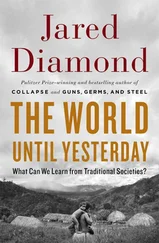Jared Diamond - Guns, Germs & Steel
Здесь есть возможность читать онлайн «Jared Diamond - Guns, Germs & Steel» весь текст электронной книги совершенно бесплатно (целиком полную версию без сокращений). В некоторых случаях можно слушать аудио, скачать через торрент в формате fb2 и присутствует краткое содержание. Жанр: 105. Описание произведения, (предисловие) а так же отзывы посетителей доступны на портале библиотеки ЛибКат.
- Название:Guns, Germs & Steel
- Автор:
- Жанр:
- Год:неизвестен
- ISBN:нет данных
- Рейтинг книги:5 / 5. Голосов: 1
-
Избранное:Добавить в избранное
- Отзывы:
-
Ваша оценка:
- 100
- 1
- 2
- 3
- 4
- 5
Guns, Germs & Steel: краткое содержание, описание и аннотация
Предлагаем к чтению аннотацию, описание, краткое содержание или предисловие (зависит от того, что написал сам автор книги «Guns, Germs & Steel»). Если вы не нашли необходимую информацию о книге — напишите в комментариях, мы постараемся отыскать её.
Guns, Germs & Steel — читать онлайн бесплатно полную книгу (весь текст) целиком
Ниже представлен текст книги, разбитый по страницам. Система сохранения места последней прочитанной страницы, позволяет с удобством читать онлайн бесплатно книгу «Guns, Germs & Steel», без необходимости каждый раз заново искать на чём Вы остановились. Поставьте закладку, и сможете в любой момент перейти на страницу, на которой закончили чтение.
Интервал:
Закладка:
THE FUTURE OF HUMAN HISTORY AS A SCIENCE • 407
as environments permit) because of the processes illustrated in such simple form by Maori New Zealand's Musket Wars. That is, societies initially lacking an advantage either acquire it from societies possessing it or (if they fail to do so) are replaced by those other societies.
Hence a second set of factors consists of those affecting rates of diffusion and migration, which differed greatly among continents. They were most rapid in Eurasia, because of its east-west major axis and its relatively modest ecological and geographical barriers. The reasoning is straightforward for movements of crops and livestock, which depend strongly on climate and hence on latitude. But similar reasoning also applies to the diffusion of technological innovations, insofar as they are best suited without modification to specific environments. Diffusion was slower in Africa and especially in the Americas, because of those continents' north-south major axes and geographic and ecological barriers. It was also difficult in traditional New Guinea, where rugged terrain and the long backbone of high mountains prevented any significant progress toward political and linguistic unification.
Related to these factors affecting diffusion within continents is a third set of factors influencing diffusion between continents, which may also help build up a local pool of domesticates and technology. Ease of intercontinental diffusion has varied, because some continents are more isolated than others. Within the last 6,000 years it has been easiest from Eurasia to sub-Saharan Africa, supplying most of Africa's species of livestock. But interhemispheric diffusion made no contribution to Native America's complex societies, isolated from Eurasia at low latitudes by broad oceans, and at high latitudes by geography and by a climate suitable just for hunting-gathering. To Aboriginal Australia, isolated from Eurasia by the water barriers of the Indonesian Archipelago, Eurasia's sole proven contribution was the dingo.
The fourth and last set of factors consists of continental differences in area or total population size. A larger area or population means more potential inventors, more competing societies, more innovations available to adopt—and more pressure to adopt and retain innovations, because societies failing to do so will tend to be eliminated by competing societies. That fate befell African pygmies and many other hunter-gatherer populations displaced by farmers. Conversely, it also befell the stubborn, conservative Greenland Norse farmers, replaced by Eskimo hunter-gatherers whose subsistence methods and technology were far superior to those of
4 O 8 • EPILOGUE
the Norse under Greenland conditions. Among the world's landmasses, area and the number of competing societies were largest for Eurasia, much smaller for Australia and New Guinea and especially for Tasmania. The Americas, despite their large aggregate area, were fragmented by geography and ecology and functioned effectively as several poorly connected smaller continents.
Those four sets of factors constitute big environmental differences that can be quantified objectively and that are not subject to dispute. While one can contest my subjective impression that New Guineans are on the average smarter than Eurasians, one cannot deny that New Guinea has a much smaller area and far fewer big animal species than Eurasia. But mention of these environmental differences invites among historians the label "geographic determinism," which raises hackles. The label seems to have unpleasant connotations, such as that human creativity counts for nothing, or that we humans are passive robots helplessly programmed by climate, fauna, and flora. Of course these fears are misplaced. Without human inventiveness, all of us today would still be cutting our meat with stone tools and eating it raw, like our ancestors of a million years ago. All human societies contain inventive people. It's just that some environments provide more starting materials, and more favorable conditions for utilizing inventions, than do other environments.
These answers to Yali's question are longer and more complicated than Yali himself would have wanted. Historians, however, may find them too brief and oversimplified. Compressing 13,000 years of history on all continents into a 400-page book works out to an average of about one page per continent per 150 years, making brevity and simplification inevitable. Yet the compression brings a compensating benefit: long-term comparisons of regions yield insights that cannot be won from short-term studies of single societies.
Naturally, a host of issues raised by Yali's question remain unresolved. At present, we can put forward some partial answers plus a research agenda for the future, rather than a fully developed theory. The challenge now is to develop human history as a science, on a par with acknowledged historical sciences such as astronomy, geology, and evolutionary biology. Hence it seems appropriate to conclude this book by looking to the future of the discipline of history, and by outlining some of the unresolved issues.
THE FUTURE OF HUMAN HISTORY AS A SCIENCE • 409
The most straightforward extension of this book will be to quantify further, and thus to establish more convincingly the role of, intercontinental differences in the four sets of factors that appear to be most important. To illustrate differences in starting materials for domestication, I provided numbers for each continent's total of large wild terrestrial mammalian herbivores and omnivores (Table 9.2) and of large-seeded cereals (Table 8.1). One extension would be to assemble corresponding numbers for large-seeded legumes (pulses), such as beans, peas, and vetches. In addition, I mentioned factors disqualifying big mammalian candidates for domestication, but I did not tabulate how many candidates are disqualified by each factor on each continent. It would be interesting to do so, especially for Africa, where a higher percentage of candidates is disqualified than in Eurasia: which disqualifying factors are most important in Africa, and what has selected for their high frequency in African mammals? Quantitative data should also be assembled to test my preliminary calculations suggesting differing rates of diffusion along the major axes of Eurasia, the Americas, and Africa.
A second extension will be to smaller geographic scales and shorter time scales than those of this book. For instance, the following obvious question has probably occurred to readers already: why, within Eurasia, were European societies, rather than those of the Fertile Crescent or China or India, the ones that colonized America and Australia, took the lead in technology, and became politically and economically dominant in the modern world? A historian who had lived at any time between 8500 b.c. and a.d. 1450, and who had tried then to predict future historical trajectories, would surely have labeled Europe's eventual dominance as the least likely outcome, because Europe was the most backward of those three Old World regions for most of those 10,000 years. From 8500 b.c. until the rise of Greece and then Italy after 500 b.c., almost all major innovations in western Eurasia—animal domestication, plant domestication, writing, metallurgy, wheels, states, and so on—arose in or near the Fertile Crescent. Until the proliferation of water mills after about a.d. 900, Europe west or north of the Alps contributed nothing of significance to Old World technology or civilization; it was instead a recipient of developments from the eastern Mediterranean, Fertile Crescent, and China. Even from a.d. 1000 to 1450 the flow of science and technology was predominantly into
Интервал:
Закладка:
Похожие книги на «Guns, Germs & Steel»
Представляем Вашему вниманию похожие книги на «Guns, Germs & Steel» списком для выбора. Мы отобрали схожую по названию и смыслу литературу в надежде предоставить читателям больше вариантов отыскать новые, интересные, ещё непрочитанные произведения.
Обсуждение, отзывы о книге «Guns, Germs & Steel» и просто собственные мнения читателей. Оставьте ваши комментарии, напишите, что Вы думаете о произведении, его смысле или главных героях. Укажите что конкретно понравилось, а что нет, и почему Вы так считаете.










